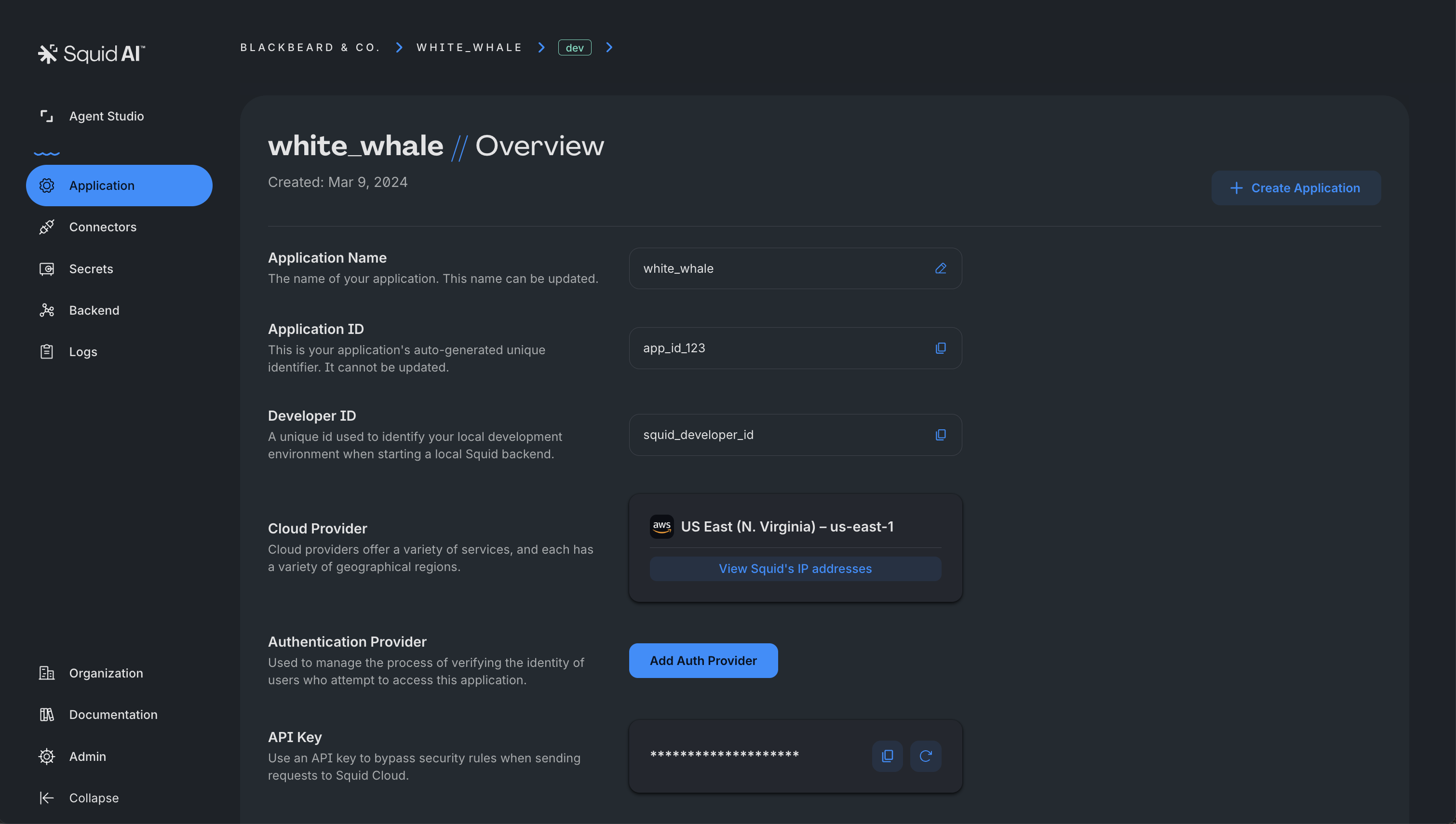Squid Console
The Squid Console is a web-based management tool written using Squid that allows users to manage their Squid applications.
Configure connectors and AI agents in the console, while also tracking usage and performance metrics. The console offers the following features:
- Managing your applications
- Creating and customizing AI agents
- Connectors management
- Authentication provider setup
- Secrets management
- Exploring backend functions
- And more...

Managing your applications
The Squid Console serves as a centralized hub for managing all your applications. It provides a comprehensive application overview that allows you to efficiently monitor and control your application's settings.
- Application Details: Get a quick snapshot of your applications, including their names, unique IDs, assigned cloud regions, and associated API keys.
- API Key Generation: Each application is assigned a unique API key to securely access backend services. The console facilitates the automatic generation and management of these keys, ensuring secure communication between your frontend and backend.
- Observability Data: Gain valuable insights into your application's performance and usage patterns through detailed observability and logging. This data is surfaced after deploying your Squid backend.
- Application Creation & Deletion: With just a few clicks, you can create new applications or delete existing ones within your organization.
AI agent studio
The Agent Studio tab of the console is where you can create and customize your AI agents. The console provides a user-friendly interface for managing your agents, allowing you to easily create, edit, and delete them without writing any code.
Use SaaS connectors, knowledge bases, and more to enhance your agents' capabilities and automate complex workflows. With Squid AI, you can leverage the power of AI to create intelligent agents that can elevate your application to the next level.
To learn more about the AI agent studio, check out the AI agent studio documentation.
Connectors in the console
Connectors are at the heart of Squid's offering, providing a powerful mechanism to connect your application to external resources. These connectors enable your Squid application to integrate with variety of external services, such as databases, APIs, SaaS services, authentication providers, and more.
You can easily set up and manage these connectors from the Squid Console, gaining access to a multitude of tools and services. Once connected, these resources become readily available as part of the Squid SDK. For more information, read about our available connectors.
Authentication provider setup
By connecting an authentication provider to Squid, you can enable secure and efficient user authentication directly in your Squid application. Squid supports multiple authentication providers, and the setup process can be easily managed from the Squid Console. Squid ensures secure token exchange between your application and authentication providers, preventing unauthorized access and data breaches.
To learn about the basics of authentication setup with Squid, read our authentication documentation. For more information on available authentication providers, check out the docs.
Secrets management
The secrets management area is where you can securely manage sensitive data like API keys, passwords, and certificates.
This feature is designed to ensure the highest level of security for your organization's critical information while simplifying the process of handling this sensitive data. Authorized personnel can easily retrieve the required secrets when needed.
Learn more about Squid's robust and versatile approach to secrets management and how it helps to ensure the confidentiality and integrity of your sensitive data.
Exploring backend functions
Squid offers versatile and robust backend functions, empowering developers to create a wide array of powerful backend logic. These include triggers that activate due to database changes, security rules that guard data access, schedulers triggered based on a cron expression, and many more.
You can easily categorize these functions and view them in the console. Additionally, the console provides detailed metrics related to each backend function's performance, offering valuable insights into each function's utilization.
By leveraging a diverse range of function types and performance metrics, you can craft a sophisticated backend logic system to meet your application's unique requirements. For more information on backend functions, read about our Backend SDK.